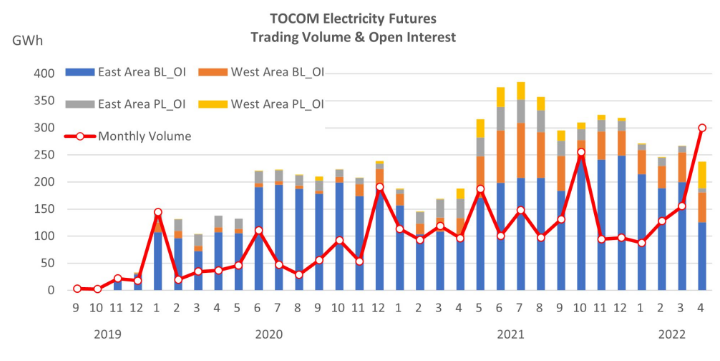TOCOM Energy
JPX Energy Market Updates(Dec.12, 2022)
Crude oil futures last Friday were trading higher on the day but facing sharp weekly losses, with oil benchmarks near to one-year lows. The contango structure has also deepened as market turns to short term over supply. Focus over the week had been largely on the wider economic negatives as the global economy's health came under close scrutiny, prompting further concerns over a deteriorating crude demand outlook.
In last week’s report, the EIA said that US commercial crude stocks declined 5.19 million barrels in the week to Dec. 2, putting stocks 9% behind the five-year average for this time of year and at the lowest outright level since mid-April.
However, high prices seem to have started to weigh on diesel demand in the US, deliveries fell for a fifth straight week to 3.55 million bpd, 12% below the 2015-2019 average, this is also the implied demand levels last seen during the pandemic year of 2020 when Covid restrictions kept a lid on economic growth.
Distillate inventories comprising diesel and heating oil build for a fourth straight week as early December demand tumbled while refining output stuck close to 2022 highs with utilization rates pushed to 95.5% as some refineries went offline.
Refineries continued to favour distillates over light ends thanks to relatively solid refining margins with output rising to its highest since mid-July at 5.33 million bpd. US distillate inventories are still below the five-year average, but the gap in stocks compared to previous years has slowly started to narrow.
In its December Short-Term Energy Outlook, the EIA expect the combination of a slight contraction in the U.S. economy and refinery maximization of distillate fuel production will reduce distillate prices in 1H23, this is at the cost of declining refining margins, the EIA forecast that U.S. diesel refining margins will fall by 19% in 2023 compared with 2022.
However, the EU’s ban on seaborne imports of petroleum products from Russia creates supply and price uncertainty for distillate markets in early 2023. Diesel and gasoil stocks in the Northwest European hub of Amsterdam-Rotterdam-Antwerp sat at 1.72 million mt, 24.9% below the five-year average late November and their lowest since 2008 for the time of year, given relatively low global petroleum inventories and the necessary time and magnitude of inventory builds needed to replenish them, the market has limited slack during the forecast period, and any unplanned supply disruption has the potential to increase oil prices quickly and significantly.
Meanwhile, in the financial markets, US Treasury bond yields marked widest inversion in 40 years amid recession fears. When investors are extremely worried about the financial future, it can lead to what is called an ‘inverted yield curve’. An inverted yield curve is where investors pay more for short term bonds than long term, indicating they do not have confidence in long-term financial conditions. Historically, the yield curve has inverted before each of the last five U.S. recessions.
In Asian markets, China announced on Wednesday the most significant relaxation of its COVID-19 prevention and control protocols since the pandemic erupted three years ago.
The relaxation of rules, which include allowing infected people with mild or no symptoms to quarantine at home and dropping testing for people traveling within the country, are the strongest sign yet that China is preparing its people to live with the disease.
Most analysts expect the path forward for China to reopen may take a few months, any initial reopening is likely to create a drag on the economy due to temporary shortage of labor supply and increased supply chain disruptions with a surge in infections likely.
Data also showed on Wednesday that China’s crude oil imports in November rose 12% from a year earlier to their highest in 10 months, as companies replenished stocks with cheaper oil and as new plants started up.
However,imports for the first 11 months of the year totalled 460.26 million tonnes, down 1.4% from the corresponding period last year.
Refined oil products exports reached 6.14 million tonnes, the highest since June 2021 and up from 4.46 million tonnes in October, reflecting China’s additional release of quotas. China's exports of refined products are expected to rise further to 6.5m to 7.1 millom tonnes in December.
On the supply side, Canadian pipeline owner and operator TC Energy had shut its 622,000 bpd Keystone Pipeline System following a leak in Kansas.
The line is a critical artery shipping heavy Canadian crude from Alberta to refiners in the U.S. it’s connected to both the U.S. storage hub in Cushing, and to the Gulf, where it is processed by refiners or exported.
The initial spike following the Keystone Pipeline leak news was short-lived but with WTI prices so close to the $70 level, we might not see much more weakness. The $70 level remains key for oil as that is where the Biden administration is expected to start to consider refilling the strategic petroleum reserve.
Traders have also been monitoring the shipping situation, with over 20 vessels carrying 14.4 million barrels of CPC crude snarled around Turkey, waiting for passage into the Mediterranean via the Bosphorus and Dardanelles strait amid an ongoing stalemate between the Turkish authorities and shipping insurers over Turkey’s demands for appropriate insurance letters due to Western curbs on Russian crude exports.
The demand for even lower delivered values is heaping additional pressure on Urals FOB differentials due to rising freight and demurrage costs, However, Russia will consider slashing its oil output according to President Putin.
There are still enormous unanswered questions that will shape the impact of the measures on the oil market, including the depth of non-European insurance markets, the appetite of some tanker owners to participate in trade with Russia, and exactly how effective enforcement of the cap can be.






